I love creating free content full of tips for my readers, you. I don't accept paid sponsorships, my opinion is my own, but if you find my recommendations helpful and you end up buying something you like through one of my links, I could earn a commission at no extra cost to you. Learn more
Works ranging from accessing far-hidden areas to accurate twisting require a socket wrench to render your mechanic life incredibly simpler.
Apart from being attached to impact sockets, socket wrenches can be used for a number of jobs. For example, you can fix your bicycle’s cycle chain, tighten and loosen nuts on your car among other nuts.
Impact sockets are a must-have accessory for impact drills. They make your work easier and they are resistant to vibration.
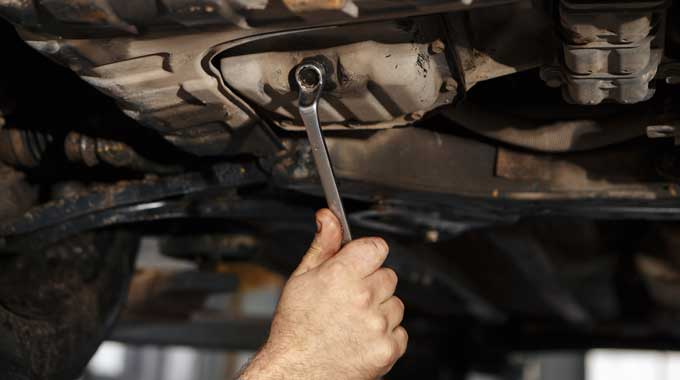
In this post we'll cover:
- What is an Impact Socket?
- What is a Socket Wrench?
- How to Use a Socket Wrench with Impact Sockets:
- How To Put A Socket On An Impact Wrench
- Advantages and disadvantages of using impact sockets compared to manual sockets
- Safety tips when using wrenches
- FAQ’s
- Can I use an impact socket for everything?
- Do you need impact sockets for impact drivers?
- Can I use regular sockets with an impact driver?
- Do impact sockets make a difference?
- Why do impact sockets have a hole?
- Who makes the best impact sockets?
- Are impact sockets stronger?
- How are impact sockets made to withstand vibration and high torque loads?
- What should you look for in impact socket sets?
- Final Thoughts
What is an Impact Socket?
Impact sockets are made of softer steel that can handle impacts better. They are thicker since steel is easier and softer to bend, although not easy to break. Softer steel takes impacts better because the entire piece of metal compresses a tiny bit while distributing the impact’s energy through the entire socket. Impact sockets are used with impact wrenches most of the time. Mechanics use impact sockets to remove seizes nuts and bolts. The sockets are sturdy and resistant to the vibration caused by an impact drill.What’s the difference between an impact socket and normal sockets?
The main difference between the two is the hardness of the material and the wall thickness. Both types of sockets are manufactured out of steel. However, the impact sockets are treated to be vibration and impact resistant. This means they are treated to a lower hardness compared to the normal sockets. Thus, they are sturdier and less prone to breakage. Never use chrome sockets meant for regular wrenches with impact tools. Always use the impact sockets to prevent shattering. Here is a set of impact sockets:Neiko Impact socket set
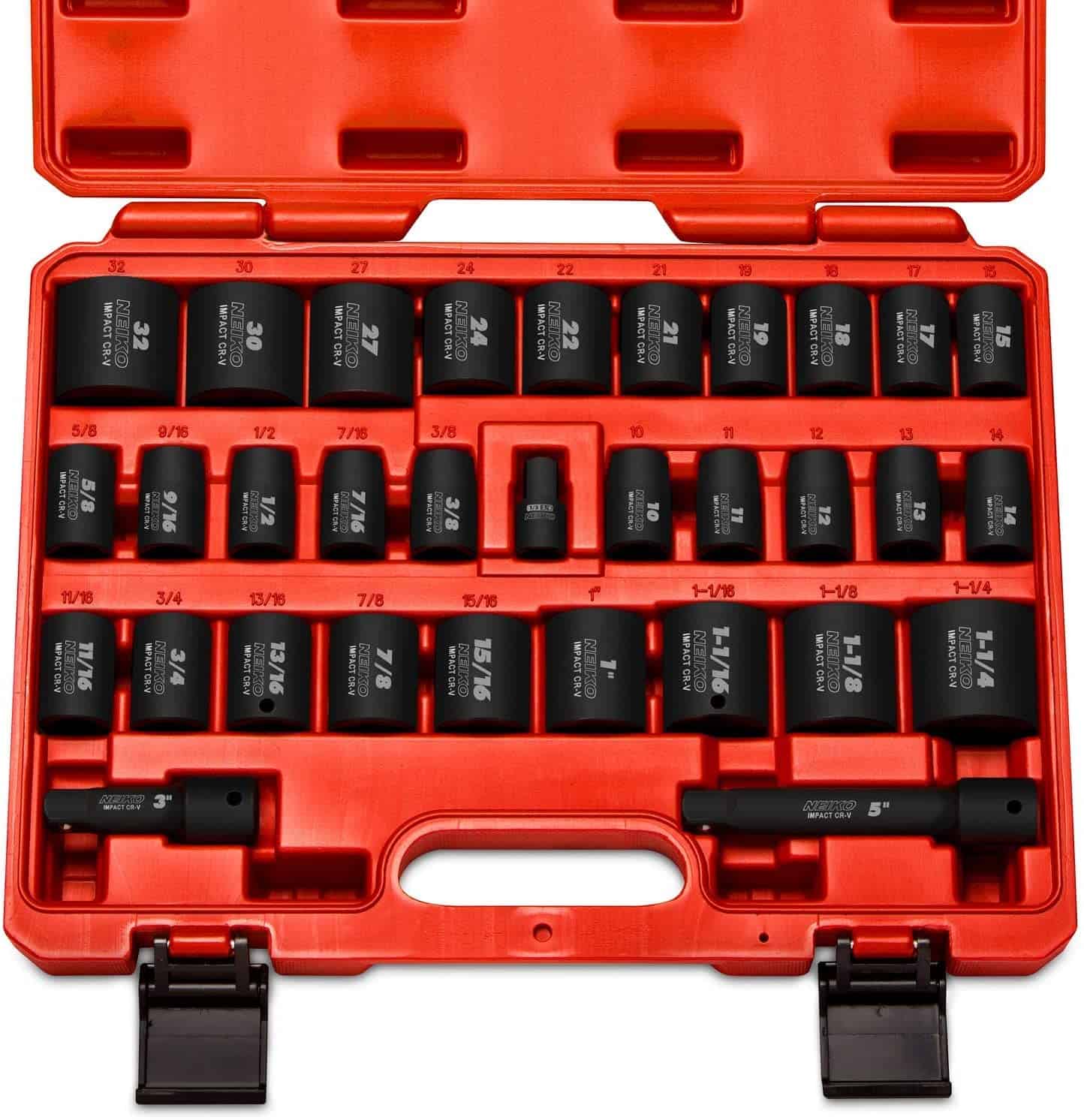
- 6-point hex socket design that prevents damage and deterioration when used under high torque
- made of heavy-duty drop-forged premium chrome vanadium steel
- can withstand extreme levels of torque changes
- laser-etched markings
- corrosion-resistant
- comes with a molded case
- affordable ($40)
What is a Socket Wrench?
A Socket Wrench is a handy tool made of metal/steel and it is commonly used by tradesmen, mechanics, DIYer’s, and individuals involved in repair/maintenance work. It is one of the most important tools in a socket set aiming at providing support for all your house and industrial works. Using a socket wrench with impact sockets in a correct manner diminishes the chances of processing problems and errors. A ratchet releases itself while moving in the opposite direction and usually tends to gear the mechanism while moving in the correct direction.How to Use a Socket Wrench with Impact Sockets:
1. Identify and select the correct socket for the right job
Different impact sockets are loaded to Socket Wrenches for various operations. Before you commence operations, you need to identify the correct impact socket size perfect for a particular job. This is called ‘sizing up’ the impact socket. Matching the socket with the size of the nut is essential for matching purposes. Ideally, you can get the correct size. However, you can try to match the nuts and the impact socket size you are planning to work on. Smaller and regular nuts are recommended compared to larger ones which are quite hard to handle.2. Match the nut measurement with the socket
Engaging in some official measurements is vital once you have identified and selected the best sizes for the job. It is essential to know accurate sizing since it makes work more comfortable by reducing the chances of further loosening or tightening of nuts. Sockets are customarily labeled with the best matches on the sides. These measurements enable you to decide on sizes accurately. Here’s a list of all the socket sizes from the smallest to the largest3. Attach the socket to the handle
First, place your wrench on the ‘forward’ setting. After identifying the correct match for the nut, attaching the socket to the handle is the next crucial step. You need to locate your selected socket’s square-shaped hole and carefully attach the handle to the shaft. You can place the bolt in the hole manually and then add the nut on the end. Place the socket over the nut. Next, make sure to pull the trigger of your wrench until you feel it tighten the nut. Identify the square knob on the handle which makes a click sound once attached to the socket. The click sound is a clear indicator that the socket has appropriately attached to the handle and can be used for operations.4. Identify the correct direction
After adequately attaching the socket to the handle, the next step is determining the correct direction. Adjust the switch found on the socket’s side before moving the socket. The switch provides you with guidance about the loosening and tightening direction. If the switch bears no direction guidance, then you can turn the switch to the left for loosening and on the right for tightening. You should always determine the correct directions before commencing work. This aspect is based on the fact the excess pressure can lead to extreme tightening which is impossible to reverse.5. Master the twists
You can master the twisting art only after acquiring the right control over the handle and the impact socket. You need to understand the different sizes of the nut you are working on and then twist. Once you figure out the amount of rotation needed for the job, you can twist as much as needed. It is possible for you to use the socket like a regular nut. However, you should possess a perfect idea of the amount of space required for twisting. You are recommended to move in the opposite direction whenever you lack enough operational space. Rather than putting unnecessary pressure, you should try repeating the twisting procedure for better results.How To Put A Socket On An Impact Wrench
Twisting a nut or a bolt requires a wrench, and the best tool which can complete this task perfectly is an impact wrench. Therefore, the impact wrench is very popular among mechanics. In spite of this, operating an impact wrench may not seem easy because of its mechanical features. Due to this, many people get confused when thinking about the setup process and how to put a socket on an impact wrench. So, we’re here with a quick guide on how to put a socket on your impact wrench.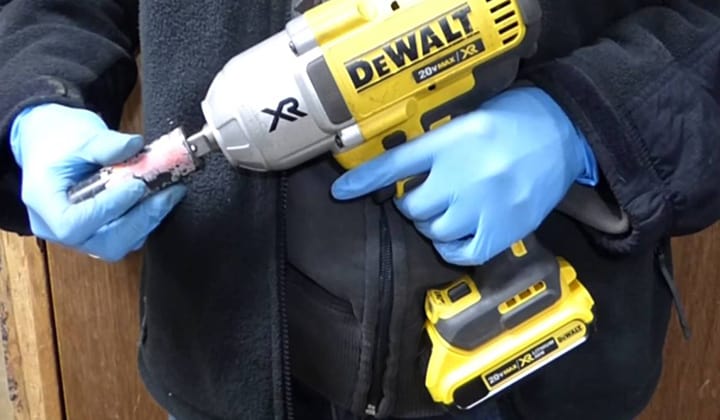
What Is A Socket For An Impact Wrench?
You already know that the impact wrench can rotate the nuts or bolts using the torque created in the wrench head. Basically, there is a socket attached to the impact wrench, and you need to connect the nut with the socket. But, not every nut works on an impact wrench. There are many types of sockets available on the market, and most of them won’t fit in with an impact wrench. Generally, you will find two major types called regular sockets and impact sockets. Here, regular sockets are also known as standard sockets or chrome sockets, and these sockets are mainly used in manual wrenches. Because, the regular sockets are made with hard metal and less flexibility, whose characteristics don’t match with an impact wrench. As a result, you should always choose an impact socket for your impact wrench. Usually, the impact socket comes with a very thin design and flexible metal. Besides, it can withstand harsh conditions and match the high speed of the driver. In short, the impact sockets are designed to fit in the impact wrenches.Step-By-Step Process Of Putting A socket On An Impact Wrench
Now, you know the socket you will use in your impact wrench. Simply, you’ll have to choose an impact socket for your impact wrench. Now let’s get straight to the process of attaching a socket to your impact wrench step by step.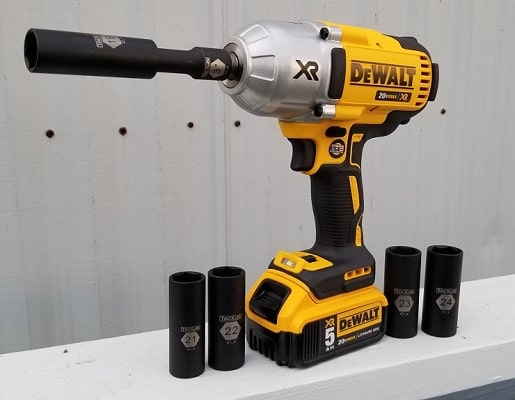
1. Identify The Required Socket
First, you need to look at the driver of your impact wrench. Usually, the impact wrench is found in four popular sizes, which are 3/8 inch, ½ inch, ¾ inch, and 1 inch. So, check the size of your impact wrench first. If your impact wrench has a ½ inch driver, you should find an impact socket that has the same measurement in its end.2. Collect The Right Socket
Generally, you won’t be able to buy the sockets individually. You need to buy a set of impact sockets where you’ll get various sockets matched with the size of your impact wrench. If you still want to buy only one that will be used for this single task, you will also have to take the measure of your nut first.3. Match With The Nut Size
Now, you need to measure the nut size. In general, the size is written on the top surface of the nut. If the writing is unreadable, you can search online by mentioning the machine name, and you will find that specific nut size. After getting the measurement, select the socket with the same measurement.4. Attach The Socket Into The Wrench head
After getting the right socket, you can now attach the socket to the wrench head or driver. Just bring the socket and push the matched end on the impact wrench driver. As a result, the socket will remain fixed at its position.5. Select The Right Direction
To get the right direction easily, you can put a little pressure on the socket after attaching it to the driver of the impact wrench. Automatically, the socket should go in the right direction. If it doesn’t happen in a single try, repeat the fourth and fifth steps to get it done.6. Twist For Adjustment
If the direction is set and the impact socket is perfectly placed into the impact wrench head, now you can push the socket further. After that, you should twist the socket for permanent adjustment. If the socket is twisted perfectly, there will be no gap between the socket and the driver.7. Retain The Socket Ring
After all the steps are completed, you should check if the ring is retained in the right place. If not, then place it nicely and lock it with the impact wrench. Now, your impact wrench is ready to be used with that socket.Advantages and disadvantages of using impact sockets compared to manual sockets
Advantages- Fewer chances of injuries caused by sockets shattering.
- Can be used to exert a greater torque to a fastener.
- Can be used with both power turning and impact tools as well as with the manual ones.
- More expensive than manual sockets
- They are only sold with a black oxide coating.
Safety tips when using wrenches
- Use the correct wrench for the right job.
- Do not use damaged wrenches before repair.
- To avoid spillage, select the correct jaw size.
- You should always wear face shields or safety glasses in areas with falling debris or flying particles among other likely hazards.
- Position your body in a perfect position to discourage losing balance and hurting yourself.
- Rather than an off-set handle, you should always use a socket wrench with a straight handle when possible.
- Keep tools clean and oiled to prevent rusting.
- Ensure that adjustable wrenches don’t slide open while in use.
- Clean and keep wrenches in a strong toolbox, tool belt, or rack after use.
- Support the head of the socket wrench when using socket extensions.
- A slow, steady pull is ideal for a wrench contrary to fast, jerky movements.• Never use a socket wrench on moving machines.
- Never insert a shim in a socket wrench to attain better fittings.
- Never strike a socket wrench with a hammer or any other object to gain more force.
FAQ’s
When in doubt whether to use impact sockets or not, we compiled this list of common questions about impact sockets and we answered them to make it convenient for you.Can I use an impact socket for everything?
No, it’s not necessary to use an impact socket all the time. Keep in mind that impact sockets are softer, therefore they do wear out faster. But, if you are fine with repurchasing them every so often, feel free to use the impact sockets for any type of wrenching and drilling job.Do you need impact sockets for impact drivers?
Yes, you need to use impact sockets with the impact driver because regular sockets can’t withstand torque and pressure so they can break.Can I use regular sockets with an impact driver?
No, you can’t use regular sockets. The normal sockets crack and break when used with impact tools. The reason is that they are made out of a brittle material that is not vibration resistant.Do impact sockets make a difference?
They definitely make work easier. The sockets absorb sudden torque changes. Therefore, they are resistant to impact and less likely to break. Although they do wear down quicker, you work faster when you use them so they are a worthy investment. What makes these sockets easy to use is their black color. They have their sizes laser-etched into them and you can identify them easily. Since they are black they are easy to spot and different from the regular sockets.Why do impact sockets have a hole?
The hole actually has an important purpose. The name for it is a retaining pin and its role is to make sure that the impact sockets and the impact gun or wrench function well together. The pin (hole) prevents the socket from falling off the end of the wrench. This can happen as a result of the intense vibrations of the wrench, so the hole is an integral part of the impact socket.Who makes the best impact sockets?
As with all reviews, there are many opinions on the matter. However, the following 5 brands are known for their excellent impact sockets:- Stanley
- DeWalt
- GearWrench
- Sunex
- Tekton
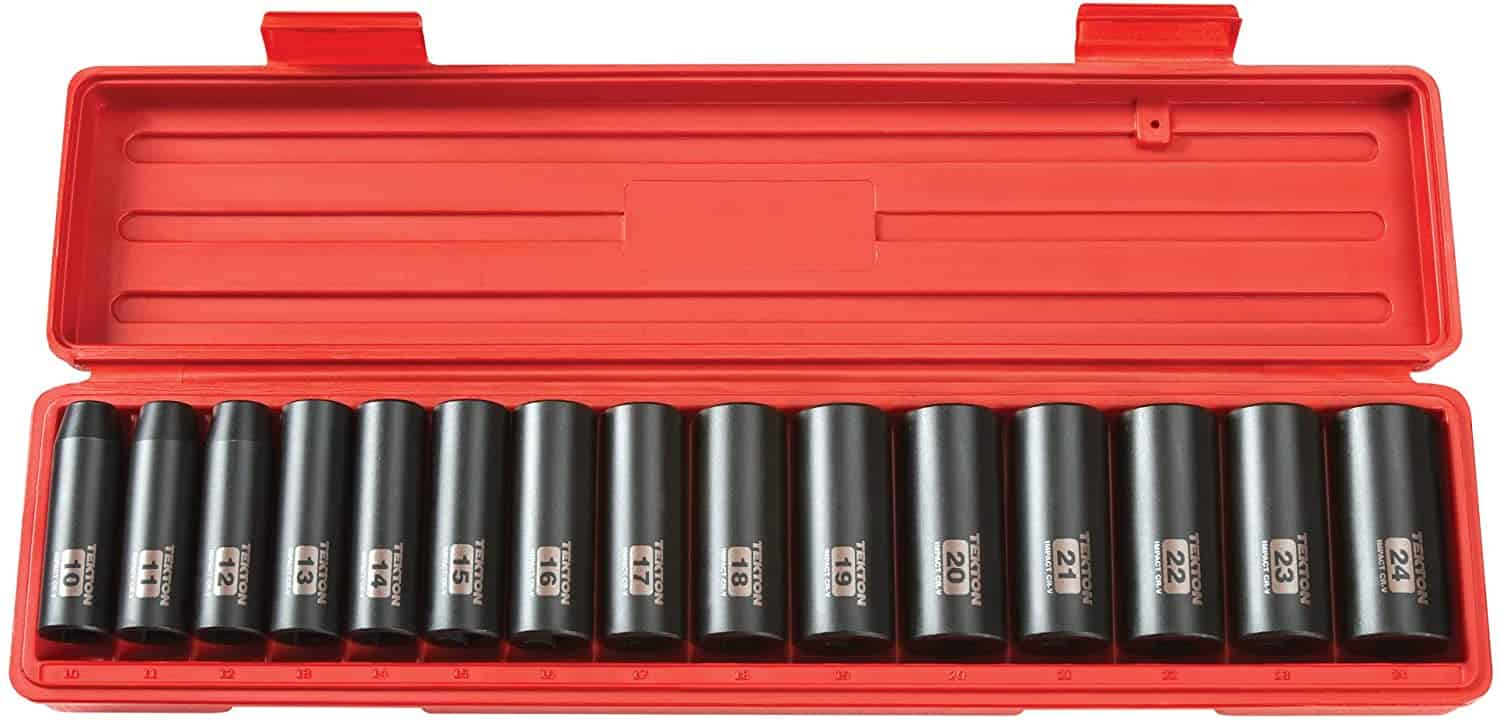
Are impact sockets stronger?
Impact sockets are designed to be used with power tools like air wrenches or electric wenches. They are not necessarily stronger but made differently. Impact sockets have a carbonized surface layer which makes it harder. Since it is surface-hardened, the socket can better absorb impact in the form of torque changes. In fact, impact sockets are made out of softer steel that cand handle the vibrations and impact better. The sockets are thicker because the steel is thicker. It is, however, easier to bend, but this doesn’t mean that it is brittle or prone to cracks, it’s just designed to handle impact better.How are impact sockets made to withstand vibration and high torque loads?
It all comes down to manufacturing. Most regular sockets are made out of a chrome vanadium steel material. But, impact sockets are made of chrome molybdenum which is less brittle. The chrome vanadium is actually quite brittle and can’t withstand the vibrations of an impact drill. The chrome-molybdenum combination doesn’t shatter under torque forces, instead, it deforms because it’s ductile.What should you look for in impact socket sets?
Before you buy a set of impact sockets, make sure to consider the following:- decide if you need shallow or deep sockets
- deep sockets are more versatile and used more often
- check if you need 6-point or 12-point sockets
- look for good steel quality – most reputable brands use high-quality materials to manufacture impact sockets
- visible marking and engravings to make it easy to tell the sockets apart
- correct drive size
- rust-resistant
Final Thoughts
Understanding the primary mechanism of an impact socket and a socket wrench isn’t a hard nut to crack. You are only required to pay close attention to the simple details. You should also monitor the thing capable of causing operational problems. Otherwise learning the operational procedures is a matter of dedication and a few minutes. Still not sure whether to get impact or chrome sockets? Check out this video and find out:I'm Joost Nusselder, the founder of Tools Doctor, content marketer, and dad. I love trying out new equipment, and together with my team I've been creating in-depth blog articles since 2016 to help loyal readers with tools & crafting tips.
